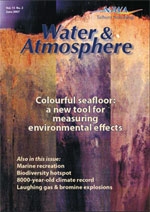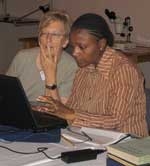PDF of this article (102 KB)

Twelve weeks in Sri Lanka
NIWA hydrologist Alistair McKerchar recently spent three months in Colombo, seconded to a team of Australians from the Snowy Mountains Engineering Corporation. They were there to prepare a plan for implementing a World Bank-funded National Water Management Improvement Plan. The five–year project will modernise water resource management in Sri Lanka beyond its traditional focus on irrigation and hydroelectric power generation. The plan has three components: dam safety, water resource planning, and hydrometeorology information systems (HMIS). The total budget for the project is about US$40 million. Alistair was team leader for the HMIS component.
Improving the hydrometeorology information systems will involve upgrading field instrumentation and equipment and installing and implementing new databases at both the Department of Meteorology and the Hydrology Division of the Irrigation Department. There will also be extensive short courses, workshops, study tours, and short-term job placements to build up staff capacity. Telemetry for four flood-prone river basins in the humid southwest is being provided through a parallel Japanese hazard-reduction aid project. In the dam safety component, an additional need was identified for flood warning for a cascade of dams on the Mahaweli, the country’s main river.
Alistair wrote specifications for the Hydrology Division for the purchase and installation of Tideda, NIWA’s environmental database software, and for the task of chart digitising within the Department of Meteorology. Other specifications were for the purchase and installation of field equipment and for its use with a rainfall-runoff model for flood forecasting.
For further information, contact: Dr Alistair McKerchar, 0-3-343 7870, [email protected]
Name that copepod: training course in Africa

In January, Janet Bradford-Grieve (emeritus researcher at NIWA) presented a two-week course in Swakomund, Namibia, to help train scientists and technicians to identify zooplankton species, and planktonic copepod crustaceans in particular. The course was designed to build capacity in the African region bordering the Benguela Current Large Marine Ecosystem (BCLME). Over the past two decades, South Africa has suffered an enormous loss of expertise in zooplankton taxonomy, to the extent that the few experts remaining are an ‘endangered species’, and such expertise has still to be developed in Namibia and Angola. These countries have a common interest in the BCLME: it is the basis of rich, variable, fisheries which are actively researched by all three countries.
There were five scientists and technicians from each of the three countries, their experience ranging from novice to PhD. Janet lectured on copepod morphology, using keys, dissection, and observation, with a strong emphasis on practical sessions and microscope identification of different zooplankton groups. Personal attention was given to everyone who asked for help in interpreting the animals they were working on, and in using the paper and electronic keys provided during the course. Experienced course members gave additional lectures on the Benguela Current ecosystem, zooplankton ecology, sampling methodology, and sample analysis.
The course succeeded at various levels, depending on the individuals’ previous experience. Participants resolved to work towards improving their access to higher-powered compound light microscopes, and to build on what they had learned by self-teaching and by collecting reference material of identified zooplankton species. They also learned there is no shortcut to individual, personal experience when it comes to improving observation and interpretation skills using microscopes.
Dr Hans Verheye, Department of Environmental Affairs and Tourism, South Africa, and Dr Anje Kreiner, Ministry of Fisheries and Marine Resources, Namibia, co-ordinated the resources to bring course members, and Janet, to Namibia from two regional capacity-building programmes: Benguela Environment Fisheries Interaction and Training Programme, funded by Germany, France, and Norway, and the BCLME Programme, an initiative of the governments of Angola, Namibia, and South Africa. In addition, the Alfred P. Sloan Foundation (USA) provided a grant through the Census of Marine Zooplankton (a project of the global Census of Marine Life).
For further information, contact: Dr Janet Bradford-Grieve, 0-4-386 0362, [email protected]
Training at NIWA
NIWA offers a wide range of couses each year. They are presented at a number of venues according to need and level of interest, and in some instances can include in-house training at your premises. The courses available are listed on our website: www.niwa.co.nz/edu/training
We also can run courses tailored to your needs. If your organisation requires specific training, please contact the NIWA Training Coordinator: phone 0800 RING NIWA (0800 746 464) or email [email protected]
